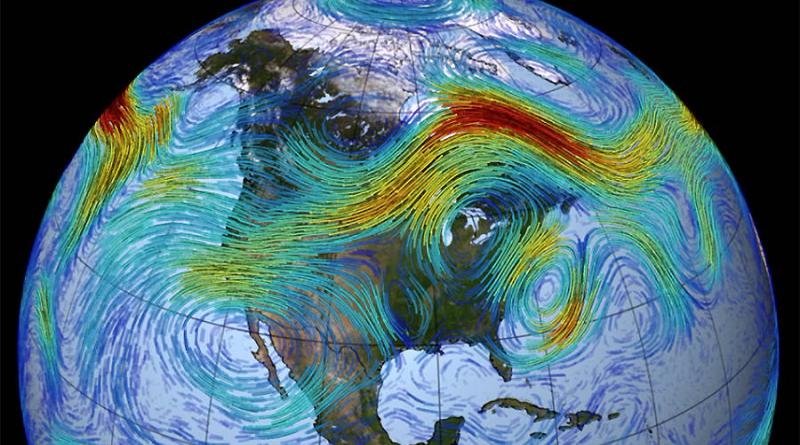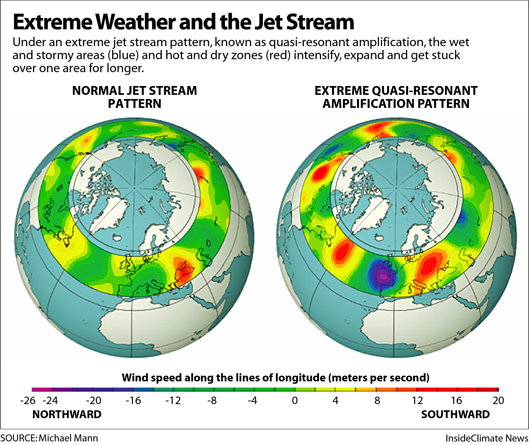Global Warming Is Messing with the Jet Stream. That Means More Extreme Weather.

A new study links the buildup of greenhouse gas emissions to more frequent heat waves, floods and droughts in the Northern Hemisphere.
Greenhouse gases are increasingly disrupting the jet stream, a powerful river of winds that steers weather systems in the Northern Hemisphere. That's causing more frequent summer droughts, floods and wildfires, a new study says.
The findings suggest that summers like 2018, when the jet stream drove extreme weather on an unprecedented scale across the Northern Hemisphere, will be 50 percent more frequent by the end of the century if emissions of carbon dioxide and other climate pollutants from industry, agriculture and the burning of fossil fuels continue at a high rate.
In a worst-case scenario, there could be a near-tripling of such extreme jet stream events, but other factors, like aerosol emissions, are a wild card, according to theresearch, published today in the journal Science Advances.
The study identifies how the faster warming of the Arctic twists the jet stream into an extreme pattern that leads to persistent heat and drought extremes in some regions, with flooding in other areas.
The researchers said they were surprised by how big a role other pollutants play in the jet stream's behavior, especially aerosols—microscopic solid or liquid particles from industry, agriculture, volcanoes and plants. Aerosols have a cooling effect that partially counteracts the jet stream changes caused by greenhouse gases, said co-author Dim Comou, a climate and extreme weather researcher at the Potsdam Institute for Climate Impacts Research and the Vrije Universiteit Amsterdam.
"The aerosols forcing was a bit of a surprise to us," Comou said. "Those emissions are expected to decrease rapidly in the mid-latitude regions in the next 10 to 30 years" because of phasing out of pollution to protect people from breathing unhealthy air.
In recent decades, aerosol pollution has actually been slowing down the global warming process across the Northern Hemisphere's mid-latitude industrial regions. If aerosol emissions drop rapidly, as projected, these regions would warm faster.
That would change the temperature contrast between the Arctic and mid-latitudes, which would dampen the warming effect of greenhouse gases on the jet stream. By how much depends on the rate, location and timing of the reductions, and the offset would end by mid-century, when man-made aerosols are expected to be mostly gone and no longer reflecting incoming solar radiation, said Pennsylvania State University climate scientist and study lead author Michael Mann.
Repeats of the Summer of 2018?
The jet stream is a powerful high-altitude wind that shapes and moves weather systems from west to east. Different branches of the jet stream undulate from the subtropics to the edge of the Arctic. In the past 15 years at least, the jet stream has been coiling up more, slithering farther north and south. When it gets stuck in the extreme pattern identified by the scientists, it leads to more deadly and costly weather extremes.
That extremely wavy pattern, called "quasi-resonant amplification," was evident during the extreme summer of 2018, Mann said.

It played out in real time on TV and in newspaper headlines about droughts, floods, heat extremes and wildfires—an "unprecedented hemisphere-wide pattern," Mann said. "It played a key role in the large-scale jet pattern we saw in late July, associated with deep stagnant high pressure centers over California and Europe."
That brought blazing temperatures and wildfire conditions to California, flooding over the Eastern U.S. and unprecedented heat to the Scandinavian Arctic region, as well as a six-month heat wave and drought across parts of Central Europe, all events showing a clear global warming fingerprint, according to scientists.
The new study focuses on summer extremes, while other research has looked at how global warming affects the jet stream in winter.
What Happens in the Arctic Doesn't Stay There
Daniel Swain, a climate scientist at UCLA and the National Center for Atmospheric Research who was not involved with the new research, said the study has some "compelling new evidence on the link between amplified Arctic warming and extreme mid-latitude weather during the summer months."
What happens in the Arctic doesn't stay there. Increased melting of reflective sea ice in summer exposes more dark-colored ocean to absorb heat, and that heats the surrounding land. As Arctic warming races ahead of the rest of the global average, the temperature contrasts that drive the jet stream are reduced, and the river of wind more frequently twists into sharp and slow-moving or stationary waves.
"When the jet stream enters this wavy state, extreme weather tends to occur on either side of the amplified ridges and troughs as the storm track becomes locked in place," Swain said. Then, specific regions experience long periods of cool and stormy or, contrarily, hot and dry weather, he added.
31 October 2018
Bob Berwyn



